New Murano Lures Old, and New, Buyers
By John Gilbert
It is impossible to not be impressed with all that Nissan has been doing in the past few years, and the new 2015 Murano luxury SUV is one of the more recent examples.
Strong engines, more engaging designs, much improved handling and sportiness, and constantly increasing sales from its lowest priced economy cars up through its costliest SUVs and its superlative Infiniti upscale line have conspired to lead Nissan to expanding popularity.
But I have a confession. As a long-time auto journalist, I have disciplined myself to be completely objective about the ingredients that go into each car, and I am thoroughly impressed with the latest technology, whatever company offers it. But I retain the right to have my likes and dislikes. Could I buy a car that has mediocre technology if I really liked the styling? Probably. Could I buy a car that has fantastic technology if I disliked the appearance? Probably not.
My confession is that I never liked the Murano. There. I’ve said it.
When it comes to Nissan SUVs, I have always felt like the Pathfinder midsize SUV might have been custom-built to fit me. The huge Armada is impressive, and angular, although it’s too large to appeal to me.
The compact Rogue, meanwhile, is a favorite of mine, and my wife Joan’s. It works in all weather, it’s big enough for us — and most SUV and crossover customers — and everything works, particularly when it’s time to go from front-wheel to all-wheel drive, and you can lock it in 4×4. It will roll happily in good weather and churn through the occasional 40-inch-plus snowfall we’ve come to know and love in Northern Minnesota.
Even the tiny, and decidedly weird, Juke has considerable appeal, because you can get it with all-wheel drive and it performs like it rather enjoys its identity crisis that makes it both a sports car and an SUV. I particularly liked the active-lifestyle Xterra, although it didn’t sell well enough to survive.
Amid that flurry of SUVs, the Murano showed up and attracted some friends of mine amid its customers. They loved it’s luxury and its features. I liked everything about it, except its styling. It looked to me as though Nissan might have taken the rugged, off-road-aimed Pathfinder and left the clay model of it too close to the fireplace, causing it to melt until it drooped down inelegantly at the front and rear. I like aerodynamics when they cheat the wind, but less when they are just droopy.
Some of those sloped-nose and rounded rear lines found themselves onto much costlier Infiniti models, and I wasn’t enamored with them, either. I know, also, that I might be unfair in my assessment, and I never let it intrude on my analysis of the mechanical wonders and creature-comforts of those vehicles so-afflicted. The reason this is the right time to come clean is this all-new Murano for 2015.
It has been thoroughly redesigned as third generation, and it looks nothing like the outgoing Murano. I like the looks of the new Murano, and I like the way it drives, with good power and impressive handling, and a firm, road-holding capability that puts it on the upper strata of moderately priced SUVs. We first drove the Murano up the Pacific Coast in California, stopping to appreciate the crashing surf and the occasional sea lions.
From the side, the new Murano is all contours and pleasing bulges, first lifting over the large front wheelwell, then meeting up with a line coming off the top of the fender, from which that contour rises gracefully back to the taillight. Meanwhile, a chrome strip underlining the side windows, kicks up into an interesting but style-only bulge that comes back down to also meet at the taillight.
From the front, the Murano looks all new, much more like a sibling of the Pathfinder and Rogue. The interior is stylishly luxurious, with a 7-inch color readout panel between the speedometer and tachometer, and a larger (8-inch) touchscreen at the top of the center stack. I have always admired Nissan’s navigation, particularly the maps, which can be adjusted to a 3D “birds-eye” view of the road ahead. However, I have grown to dislike touch-screens, only partly because one of my favorite stay-alert tricks on longer trips is a large sack full of popcorn, with butter and salt, please.
Eating popcorn slowly, one kernel at a time even, provides a steady crunch that is a welcome aid to alertness, but a little butter residue on the fingertips is not the proper recipe for operating a touch-screen. Even without the butter, it doesn’t take many fingertip-taps to pretty much cover the touch-screen with funny little fingertip marks — annoying enough to make you happy that Nissan also provides a couple of push-buttons to operate audio controls.
Other neat changes are in aerodynamics, where the coefficient of drag has been reduced impressively, and in creature features such as a large moonroof, and zero-gravity seats, which decrease stress and fatigue. The heated and cooled front seats and heated rears have more support for the lower femur and hips. Enlarged rear storage capacity offers expanded area behind the second row of seats.
A remarkable feature of the new Murano is the quietness inside, thanks to wider acoustic laminated glass in the windshield and hood insulation.
Use of high-grade steel helps lower the weight by 146 pounds on the Murano, which stays on the same platform, and maintains the 111.2-inch wheelbase, while lengthening by 3 inches to 192.8. Width is also increased by 1.3 inches.
While nobody quarrels with Nissan’s ability to build engines, there is an interesting philosophical thing going on with Japanese automakers. Apparently inspired by higher-powered and more-efficient engines from South Korea’s Hyundai, Mazda and then Honda redid their engines, modernizing them with direct injection and improving both power and fuel economy. Toyota and Nissan, on the other hand, have stayed with their engines, with port injection, which, good as they have been for over a decade, may leave them a jump behind in the technology game.
The 3.5-liter V6 in the Murano is familiar, refined to 260 horsepower and 240 foot-pounds of torque. The transmission verifies Nissan’s world-leading devotion to CVTs — continuously variable transmissions — which adjust engine speed by a variably enlarging set of pulleys rather than planetary gears. That can seem boring, because the engine tends to drone rather than rise to a peak, but it is efficient, and there is a manual-override capability that allows the driver to manually step up the cables to simulate a seven-speed automatic transmission.
Thicker stabilizer bars and improved steering make the new Murano corner and handle much better, and we swept around some twisty curves with smooth stability just to prove it. EPA fuel efficiency estimates are 21 city, 28 highway. Advanced safety items such as blind-sport detection, forward warning and emergency braking, and along with the full 360-degree monitoring system shown on the nav screen, many of the features can be ordered separately or by class.
The base Murano S starts pretty well equipped, and you can move up to SV, SL, or Platinum. The base vehicle starts at $29,995 with front-wheel drive, and works up to $40,000 for the Platinum with all-wheel drive and the Navigation package. Nissan foresees a 50-50 split between front-drive and all-wheel drive.
If you liked the looks and features of the current second-gen Murano, you’re sure to be impressed with this new third-generation model for 2015. And if you never did like the Murano, there’s a fighting chance you’ll still like the new one.


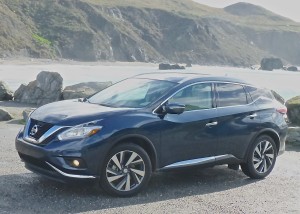
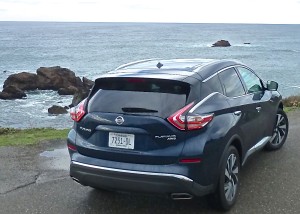
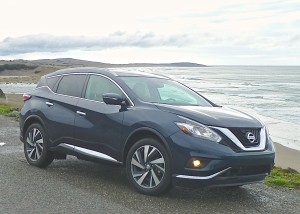
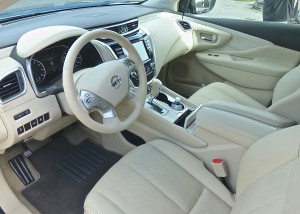
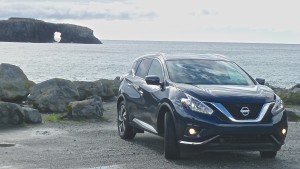
 John Gilbert is a lifetime Minnesotan and career journalist, specializing in cars and sports during and since spending 30 years at the Minneapolis Tribune, now the Star Tribune. More recently, he has continued translating the high-tech world of autos and sharing his passionate insights as a freelance writer/photographer/broadcaster. A member of the prestigious North American Car and Truck of the Year jury since 1993. John can be heard Monday-Friday from 9-11am on 610 KDAL(www.kdal610.com) on the "John Gilbert Show," and writes a column in the Duluth Reader.
John Gilbert is a lifetime Minnesotan and career journalist, specializing in cars and sports during and since spending 30 years at the Minneapolis Tribune, now the Star Tribune. More recently, he has continued translating the high-tech world of autos and sharing his passionate insights as a freelance writer/photographer/broadcaster. A member of the prestigious North American Car and Truck of the Year jury since 1993. John can be heard Monday-Friday from 9-11am on 610 KDAL(www.kdal610.com) on the "John Gilbert Show," and writes a column in the Duluth Reader.